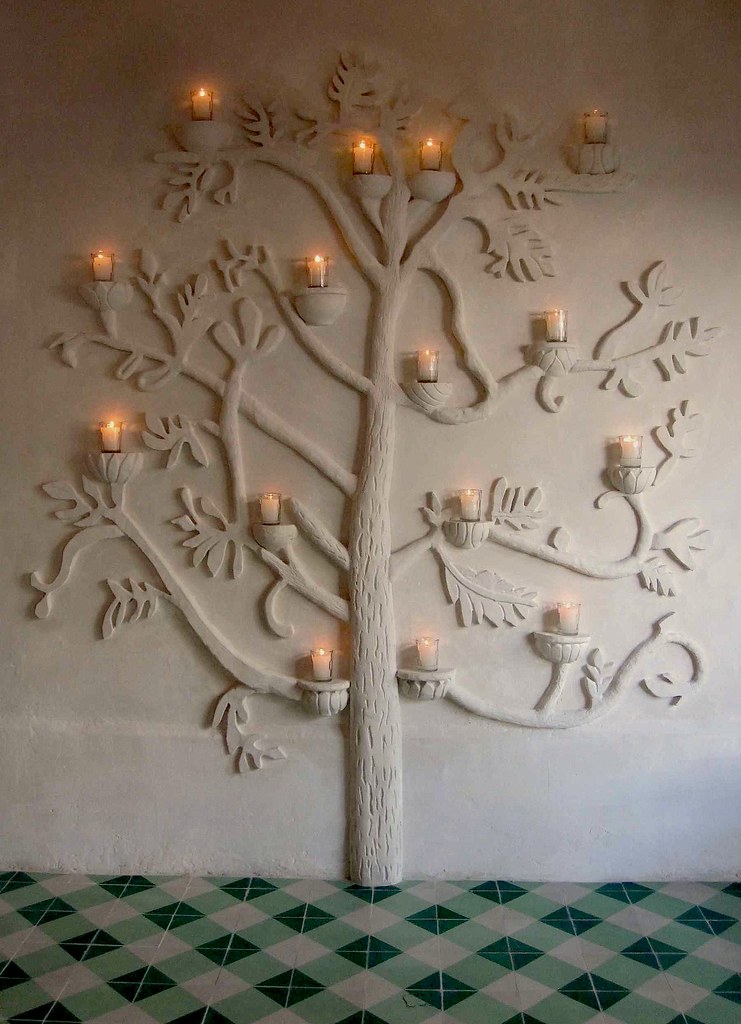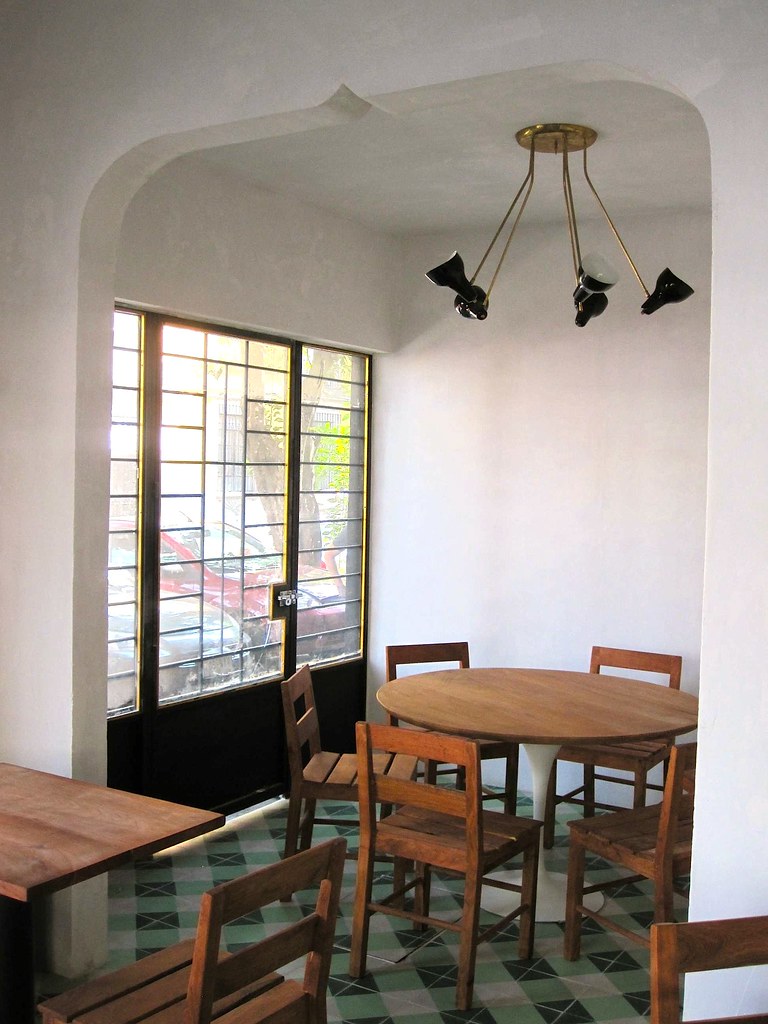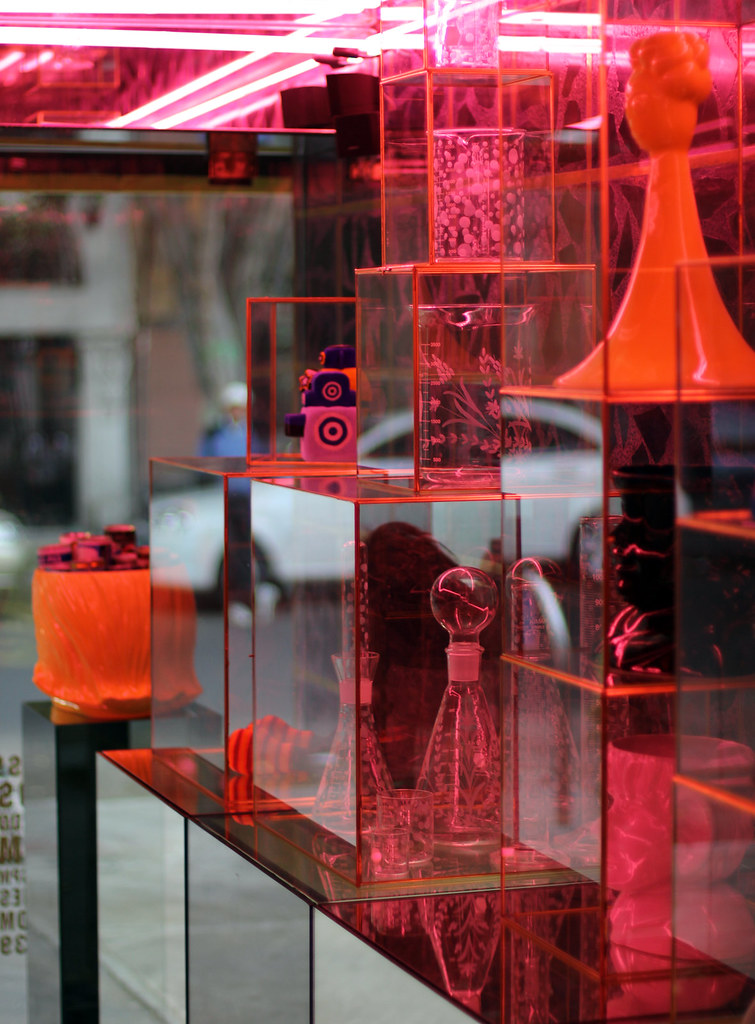sort of these Darth Vader/Ellsworth Kelly alter egos I think. "

"I was really interested in the method of carving with chainsaws
to build natural forms with really robust man-made textures."
- Charles de Lisle 2012

I distinctly remember discovering the interiors created by Charles de Lisle a year or so ago. His work is the result of 25 years of working within the art of ceramics, metalwork, custom furniture, product design, decoration and interiors. His "handwork" is evident, allowing him to create residential and commercial spaces that are inviting, timeless, thoughtful, and poetic. In his widely published project, the William Wurster Ranch in N. California, Charles created a perched brass/rope branch chandelier over a light blue laminate and ply table which energized the whole space. In this interior space for the SF Showcase, his modernist forms push and pull the interior dimensions, recalling elements of Josef Frank, Stanley Kubrick, and Adolf Loos. (It also appears as if the forms of "the chainsaw chairs" were first revealed in this space.)
His sense of color, earthy textures, vibrant patterns, and materials are strictly his own. In 2011, Charles de Lisle introduced a collection of furniture & lighting at SF20/21: San Francisco 20th Century Art and Design Show. This week, June 11-17, at Design/Miami Basel, he is showing his chainsaw chairs and mirrors via Hostler/Burrows Gallery. In addition, he recently completed the interior for a cafe in Mexico City. In our conversation, he explained how he found himself "surprised about the how Mexico city has this feeling of potential, very different than here in the states. " Thank you Charles. - David John

What was the starting point for these new works?
I started working on furniture just for the sake of exploring forms and materials. My background was in ceramics and I was missing the immediacy of "making" versus designing. This form was initially made up in upholstery, and morphed into wood at a time where I had met an artist who assisted Northern Californian sculptor JB Blunk 30 years ago. We began talking about working on some projects together as I was really interested in the method of carving with chainsaws to build natural forms with a really robust man-made textures.
This work is all about the moment and the individual piece. We search for wood, then let the shape, dimension and character of the specific cut help determine the final form. Not a new idea by any stretch, just where I happened to be.
Where did you source this wood from?
The chairs are comprised from one, 17 foot long redwood slab that was salvaged from a grove in Sonoma county where George Nakashima pulled material for his redwood tables in the 1970's. The black finish is shoe leather dye, made in the Bay Area, and is the same satin method JB worked with as well. It saturates the grain in a intense and deep black, which allows the hand and mark-making to be seen in the reflection of the light on the surface.
I'm interested in both the story that the making references, as well as a new story that happens by combining different visual languages. The forms are all very internal and bold for me, sort of these Darth Vader/Ellsworth Kelly alter egos I think. We are working on other characters right now, benches, dressing mirrors, tables, we will see what kind of family they grow up to be.
Why are you motivated to make objects? Does it mean something specific to you?
I'm not sure what object making means to me, other than it is an outlet for expression. I've always been a maker of things. I think in the sculptural format, and I have this ability to engineer parts in my head then realize with my hands, or via drawing. I love the act of "taking away," a sense of carving, editing, and deconstructing. This combination of engineering and dismantling interests me, and I believe it comes through in the forms & styles I gravitate towards making.

"Inspired by the traditional Mexican "tree of life" bas-reliefs I had seen in old haciendas.
Ours was made in plaster by the grandson of one of the last sculptors
in the city to create and repair the relief work in the old churches."

You recently completed a project in Mexico City, the Bistro Maximo. What area of town?
Mexico DF, Colonia Roma at the corner of Zacatecas and Tonala
How do you go about designing an international project?
I was very lucky to be having lunch on my first trip to Mexico in a small retreat in Yelapa, where what was being served was unbelievable. I became friends with the chef and his girlfriend and we realized we all had the same obsession with food, rented a car for a day and went off in search of local eats in the western mountains. Months later they called and had been looking at spaces around La Roma in DF and asked if I would come down and help. From there we combined our individual talents and learned how to build the restaurant together.
Did you spend a lot of time there?
Every month or so I would head south to work on the space. I traded my time for the chance to visit the city and learn from a natives perspective.
First impressions of Mexico City?
Mexico City has a great sprawl that still feels both local and super-urban simultaneously. It's one of those fantastic cities that shows its wear on the surface... You can clearly see each moment where the economy or the culture flowered through its{still intact} buildings : Hacienda, colonial, 1940's deco, 60's modern, and now, contemporary. There is also this interesting mix of the dryness of the surrounding desert, and the humid, dense tropical that permeates your senses… I love visiting.
Any favorite spots to visit while there?
The Luis Barragán house I've toured twice and still find it unbelievable. The Jose Vasconcelos Library is a great, And I really have become dependent on early breakfast at Fonda Las Margaritas.
Is there an aspect of Luis Barragán's work that appeals to you?
The Barragan house really resonates with me: the subtle light, the color palette, and it's overall dynamic quality. Each room had a path and a way that the light and the architecture led you through a very focused experience, more so than a house just to live in.
This house seems to have been made for contemplating. The pink, mango and gold colors in the entry hall, hands down is one of the most amazing combinations I have witnessed. The big handmade lamps and table-scapes of artifacts, the simple low furniture, an appreciation for ceramics. All things I love to see.


the Bistro Maximo, Mexico City,
interiors by Charles de Lisle
Did you connect with a design community while in Mexico City?
Somehow I haven't yet dug into the design world there as I have been distracted with connecting with contemporary art or finding myself surprised about the how city has this feeling of potential, very different that here in the states. Everyone there seems more eager to talk or try something new, or be excited about opportunity. Design and food culture seems to have room for creativity.
The materials that were used for this project?
Everything was made by hand, the menu was to be local and fresh, so the idea was to mirror that and create a local styled space that reflected something traditional and Mexican, but would also feel fresh. We found the simple form of Mexican farm chairs we came across and came up with a modern version with pared down details. The napkins were made on hand-looms in Oaxaca, the dishes all from a small second generation ceramics shop in the city, traditional concrete floors, black painted trim. We collected from our travels both vintage items for the restaurant and great contacts for craftspeople to work with.
The floor tiles. Were they made in Mexico? Are they Concrete?
The green gingham floor tiles are concrete and were custom colored at a Mexican factory specializing in this old Moorish style. Super bright and graphic referencing these colorful screen-printed metal tables found in the market food stalls and fondas.
Where did you shop for the Italian lighting?
I was introduced by a friend to Claudia Fernandez, a Mexico City artist, who has a showroom of vintage furniture and lighting in an amazing old colonial house. She and I both have a similar, strong affinity for Italian design. Most of the fixtures are 1960's Lightolier.
Where is her shop?
Oh god...I can't remember. It was pouring rain my first trip there...! My office might have the address at my office.
Tell me about the the tree?
It was inspired by the traditional Mexican "tree of life" bas-reliefs I had seen in old haciendas. Ours was made in plaster by the grandson of one of the last sculptors in the city to create and repair the relief work in the old churches. Instead of holding saints, we decided on gold pinstriped church candles. He cast and carved all the parts in a studio on his roof, and then assembled and finished at the site.
I admire how you use a single candle in a few different interiors.
Thanks ! I think the walls above those shelves at Maximo are super black from soot now. I love that too.
-----------------
"Charles de Lisle's experience spans the last 25 years working within the art of ceramics, metalwork, custom furniture, product design, decoration and interiors. Following 10 years as principal and partner of the firm De lisle, Philpotts & Staub, Charles founded his own office the Charles de Lisle Workshop. He continues to assist his clients produce inspired, award-winning residences, hotels & restaurants."
visit Charles de Lisle Workshop...
----------------



